
|
Sale 22
Manuscript and Collectibles Auction
| Lot |
Photo |
Description |
Realized |
Lot 414 |
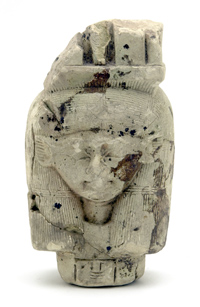 |
Fragment of a Hathor Sistrum in Unusually Colored Limestone. Egypt, 26th Dynasty, 664-525 BC. Carved from greenish limestone, resembling the Egyptian's beloved blue-green faience, this object is finely styled and crafted. The sistrum is comprised of janiform heads of the goddess Hathor, with a thick wig, her expression serene, and her attributes of cow ears. Her crown is an open door shrine (naos), with central uraeus (cobra) emerging. Below the goddess' neck is a columnar section, inscribed with hieroglyphs, which forms part of the handle to the sistrum. This is inletted on the bottom where it would have attached to the rest of the handle. Carefully reassembled from several large pieces, the object shows the hazards of the millennia, but does not obscure the quality of the art that was wrought. The limestone, almost a blue green within, has faded to a pale green and off white at its exterior surfaces. Height: 4-7/8". A quality Egyptian sculpture of some size. Rare!
Estimated Value $1,000 - 2,000.
Hathor was the goddess of music, joy, love and motherhood. However, her serene expression belied another, darker side: she punished rebellious humans, was vengeful, and almost destroyed the whole human race.
View details and enlarged photo
| Realized
$2,070 |
Lot 415 |
 |
Terra Cotta Figurine of Mother and Child. Roman Phoenicia, 1st-2nd century AD. Mold-made in a pinkish red ware, the woman is clad in a short-sleeved chiton, and has a cloak draped about her shoulder and waist. She stands on a high squarish plinth and supports a similarly dressed child at her shoulder. One foot missing, otherwise in choice condition, with traces of red and yellow paint along cloak. Height: 7-1/2", and mounted on custom Lucite stand. Perhaps a votive for a successful childbirth, since many similar figures are known where the child is absent and the woman is obviously pregnant.
Estimated Value $200 - 300.
View details and enlarged photo
| Realized
$518 |
Lot 416 |
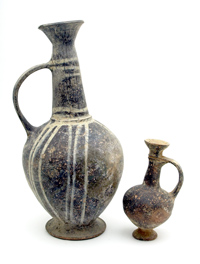 |
Lot of Two "Bilbil" Juglets. Cyprus and Canaan, c. 1550-1200 BC. From the Late Bronze Age, the time of the Biblical Judges, two examples, large and small, of an interesting pottery type peculiar to Cyprus and Palestine. From Cyprus, the largest bilbil well potted in buff ware with gray slip and overpaint of radiating white lines along the body and circular bands at the neck. Similar but smaller, and somewhat less well made, is the Canaanite version - in red-tan ware with deep gray slip. This devoid of ornament. Both with slim single strap handles, and the distinctive "back slant" to the vessel. Smallest in choice condition. The Cypriote piece with a few discreet repairs, otherwise in exceptional condition, and the largest example we have seen of this type - thus rare as such. Heights: 11"; 5". Lot of 2 pieces.
Estimated Value $500 - 750.
Many of these #bilbil# jugs were imported into Canaan, primarily from Cyprus, along with locally made products. They were probably employed for the opium and medicinals trade. Analysis of substances found inside some of them has shown that they were used to hold the drug opium. The shape of the jug is strikingly like that of an upturned poppy head. Cf. Ruth Amiran, Ancient Pottery of the Holy Land, pl. 54, no. 7.
View details and enlarged photo
| Realized
$805 |
Lot 417 |
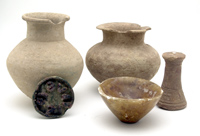 |
Group of Ancient Holyland Antiquities. Near East, c. 1800 BC. - 600 AD. A variety of objects from lands touched upon in the scriptures, including a small Egyptian bowl in alabaster (Middle Kingdom?), with an old repair to its base. Its surfaces coated with a brown resinous material, the repair work and "patination" are typical of 19th century restorations. Also two vessels with ovate bodies (and chipped rims); one Roman era, the other Hellenistic or earlier. Also in bronze, a circular Byzantine bread stamp, with Greek inscription. Lastly, a small narrow chalice in terra cotta, its sides adorned with a frieze of crosses and amphorae. Likely made 100 years ago for the tourist trade. Heights: 1-3/4" - 4-7/8". Lot of 5 pieces.
Estimated Value $100 - 200.
View details and enlarged photo
| Realized
$127 |
Lot 418 |
 |
Roman Ceramic Vial from the Moshe Dayan Collection. Judaea, c. 100 AD. Neatly potted vial, in coarse pink ware, with traces of red-brown slip. Bottle with piriform body and thick columnar neck, and very well preserved but for three trivial chips on bottle's rim. Inscribed in ink on one side towards base: "Samaria, A.D. 100, M. Dayan." Attractive, both as an artifact of ancient Judaea, but also as a momento from Isreal's most celebrated general of recent times, who was both an archeologist and a collector. Height: 4-7/8".
Estimated Value $100 - 200.
View details and enlarged photo
| Realized
$299 |
Lot 419 |
|
Ancient Lamps from Judea, 2nd century AD, and later. Earliest is Roman with molded design in discus (a sheep? among other objects), with dark red to brown slip; nicely mounted on custom display case. In addition are two "slipper" lamps from the Byzantine period, in coarse pink-tan ware, both with heavy earthen patinas. Plus, uncertain Near East, likely Late Antique, in reddish terra cotta an amusing figural handle to fragmentary lid. Handle of a stylized boar, with beady eyes, straddling the topmost portion of the incise-decorated lid. Lastly, a lid from a pyxis, probably Cypriote, c. 500 BC., with painted linear ornament. Objects in very fine to excellent condition. Lengths: 3" - 3-3/4". Lot of 5 pieces.
Estimated Value $150 - 250.
View details
| Realized
$184 |
Lot 420 |
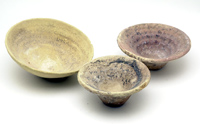 |
Lot of Three "Devil Trap," or Judeo-Aramaic Incantation Bowls. Near East, c. 5th-7th centuries AD. Lot of three fairly crude buff clay bowls, the largest conical with rounded bottom, along with two smaller examples, shaped like flared cones with flat bottoms. The interior of the largest with painted inscription in Judeo-Aramaic forming a multiple line spiral within. The next size smaller bowl similar, but with less careful lettering. The last and smallest similar, but with even more debased letter forms, so that the writing would be more properly termed a "psuedo-inscription." Two bowls yellowish in color, while the middle bowl with reddish violet tint. Largest with chipping to base, the second with minor rim nicks, otherwise bowls complete and without the repairs and re-assembly. Diameters: 5" - 6-3/4". Lot of 3 pieces. Interesting, and always in demand.
Estimated Value $700 - 1,000.
From Mesopotamia to Palestine, the ancient peoples of the Near East believed that a demon-goddess named Lilith was responsible for infant death, disease, the infidelity of husbands, and like disasters. However, certain incantations, or naming and/or calling on certain beneficent deities could repel or entrap her and thereby rendering her unable to do her worst. Spiraling towards the center, the magical spell would weave a snare to entrap the evil demon. Thus these magic incantation bowls were also referred to as "demon bowls" or "devil-trap bowls." They were buried under the foundations of homes, after reciting the spells inside them, so that they would protect the family living in the home above them.
View details and enlarged photo
| Unsold |
Lot 421 |
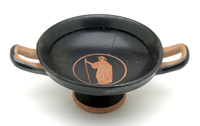 |
Attractive Attic Kylix. Athens, c. 460-420 BC. The drinking cup well made with choice glossy to semi-glossy black glaze, and reserve areas in orange at bottom of foot and inner edges of handles. At tondo, within the cup, a woman (maenad?) stands left, holding a staff, clad in chiton and himation. Figure nicely drawn, with black lines for the main form, and light red lines (diluted glaze) to delineate the pleated folds of the chiton. Behind her, perhaps a psuedo-inscription in two lines. Reassembled from several large pieces, the cup has a modest area of restoration (in the black field) in part of the cup, plus the stem and interior of the foot. The figural art itself with nearly insignificant spots of touch up. Interestingly the top of the cup's foot shows evidence of ancient repairs (holes for metal staples). Rest of cup with choice, pristine surfaces. An excellent yet affordable example of the most desired of ancient ceramic artifacts. Width: 9-1/2".
Estimated Value $3,000 - 4,000.
View details and enlarged photo
| Realized
$1,898 |
Lot 422 |
|
Charming and Pristine Owl Cup. Athens, or Apulia, c. 400-350 BC. The red-figure skyphos very well crafted, with black glaze on pink-orange ware. On either side an owl stands frontal, between two upright sprigs of olive. Intact and suprisingly free of the usual repairs; only restoration being a handful of small paint touch ups to the rim. A very pleasing example of its class. Height: 2-7/8"; Width: 5-7/8".
Estimated Value $500 - 750.
View details
| Realized
$978 |
Lot 423 |
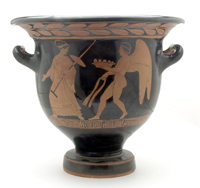 |
A Fine and Large Bell Krater. Apulia, c. 350-340 BC. One of the most popular ceramic forms of the South Italian Greeks, this vessel finely potted and painted by a superior artist. Side A: Nude Eros approaches a maiden, her head turned back, and presents her with a basket of loaves(?) and a fillet, all on a groundline of meanders. A border of laurel leaves above encircles the vase below its exterior rim. Side B: Two cloak-draped youths stand in conversation, each holding a walking stick; hanging cloth in between. Also a border of meanders beneath. Vase reassembled from large fragments, with modest restoration, with none affecting any significant portions of the figures. Aside from a small patch of flaking and fading on reverse side, the preservation of surfaces is choice, with the glaze mostly glossy and free from weathering. Height: 11-1/2". Simple and elegant, with fine figural art, this is a truly choice antiquity!
Estimated Value $3,500 - 4,500.
View details and enlarged photo
| Realized
$6,095 |
Lot 424 |
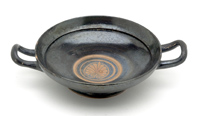 |
Handsome Red-figure Stemless Kylix. Apulia, c. 350-330 BC. Kylix of usual form, but sits in wide ring foot. The glaze an extremely glossy silvery black, with olive tint, along with reserve bands of red on underside of foot. The tondo shows a graceful acanthus palmette, centered within reserve circles of red. Repair with trivial restoration to one handle, otherwise intact and pristine. Width: 9-3/4". A wonderful object -- so classically Greek!
Estimated Value $1,500 - 2,000.
View details and enlarged photo
| Realized
$863 |
Lot 425 |
 |
A Charming Gnathia Ware Kylix. Apulia, c. 340-330 BC. This example with deep cup-like bowl, short foot, and typical graceful handles. The black glaze faintly olive-tinged, but smooth and glossy, with reserve bands of red at foot. In applied white and yellow colors along with incised details, one side of kylix with flying dove framed by pendant vine motif. The other side similar, but with two rosettes instead. Rims on both sides with short borders of painted and incised tongue and egg pattern. Vessel recomposed from large pieces, with only minor restoration and paint touch up. Otherwise, condition near pristine. Width: 5-3/4". Choice!
Estimated Value $400 - 500.
View details and enlarged photo
| Realized
$489 |
Lot 426 |
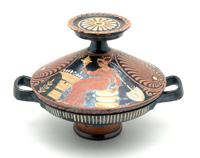 |
Outstanding Red-figure Lekanis. Apulia, c. 330-320 BC. The lekanis, a lidded dish, especially popular in Magna Graecia, in southern Italy. Its base of kylix form, but the rim is flanged to receive a lid. This in handsome black glaze, with reserve bands of red on the short foot, along with applied white petals with yellow overglaze around the exterior walls of the dish. The intricately painted lid shows a woman of fashion, and a rather effeminate Eros seated and holding various objects. These two are separated by elegant and large acanthus palmettes on either side. Lid handle with central rosette within border of waves along rim; waves also edge lower rim of lid. The figural drawing quite fine for this period, with added detailing in applied white and yellow. But for a few negligible chips, the vessel complete and intact, without repairs or paint touch -- the condition virtually pristine. Width: 9-3/4". Height: 7". A splendid artifact, so reflective of the Italian Greek's love of the sumptuously ornate.
Estimated Value $2,000 - 2,500.
View details and enlarged photos
| Realized
$2,990 |
Lot 427 |
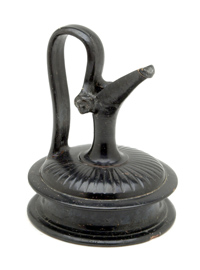 |
Lovely Black-Glaze Epichysis. Magna Graecia, perhaps Apulia, c. mid-4th century BC. This distinctive vessel with squat, spool-shaped body, rounded and fluted shoulders, along with a high arching strap handle and narrow trough-like spout. At either side of spout a sharply molded female mask -- finely detailed and attractive. The fine black glaze glossy and nearly complete. Small chip at base of foot, and narrow age crack across shoulder and around base of neck, otherwise bottle in choice condition and appears sound and stable. Handsome example of type. Height: 5-1/8".
Estimated Value $300 - 400.
View details and enlarged photo
| Realized
$299 |
Lot 428 |
 |
Splendid Gnathia Ware Epichysis. Apulia, c. 340-330 BC. This distinctive vessel form with short, spool-shaped body, rounded shoulders, and high arching, almost angular strap handle and narrow tubular spout. At either side of spout molded female masks. Fine black glaze nearly covers the vessel but for three reserve bands of red wash on the body. Along the shoulder, in applied colors, two rows of grape vines in yellow and white flank a central red band. Above and below borders of beading in yellow, with row of petals at neck and tongue and egg pattern at shoulder rim in white. Small chip at foot and shoulder rims, otherwise bottle intact and in superb condition. A fine and handsome artifact! Height: 6-1/2".
Estimated Value $500 - 650.
View details and enlarged photo
| Realized
$518 |
Lot 429 |
 |
Three Choice Xenon Ware Miniatures. Campania or Apulia, late 4th century BC. The three charming pieces all replicating larger pottery forms. Shapes include: two mug-like olpes, and a Messapian-style kantharos, and all with excellent black glaze. Again, all with red overpaint ornament. The krater with two panels having wave patterns, each different from the other. One olpe with petals at shoulders and wreath at waist, while the other is similar, but with meander pattern at waist. All intact and beautifully preserved. Heights: 2-1/8" - 2-1/2". Delightful little antiquities!
Estimated Value $350 - 500.
View details and enlarged photo
| Realized
$322 |
Lot 430 |
 |
Three Choice Xenon Ware Miniatures. Campania or Apulia, late 4th century BC. The three charming pieces all replicating larger pottery forms. Shapes include: sessile or stemless kantharos resembling a bell krater, a trefoil oinochoe, and a Messapian-style kantharos. The first two with black glaze, the latter in lovely olive-silver gray. All with red overpaint ornament, two with wave patterns, with an acanthus palmette for the oinochoe. Paint a little faded on the palmette, otherwise all pieces quite pristine and exceptional. Heights: 2-1/8" - 2-7/8". Attractive and decorative little antiquities!
Estimated Value $350 - 500.
View details and enlarged photo
| Realized
$357 |
Lot 431 |
|
Unusual Xenon Ware Guttus. Campania, c. 340-330 BC. The vessel of discoid shape, on ring foot, with upright handle to the side, and slim spout to front. Finely glazed in black, the central discus with facing head of a youthful satyr -- his features bold, if a bit coarse, and his hair fairly luxuriant. Applied over the glaze, as a red paint, is a pattern of petals bordering the discus, with a row of "egg and darts" below, along the sides. A few trivial chips at spout and along foot, otherwise guttus is remarkabley well preserved, and without repairs. Width: 4-5/8".
Estimated Value $950 - 1,250.
The guttus is generally defined as being a "lamp filler," for easily pouring oil into the lamp's reservoir. However many examples of this group have thick spouts with wide, often ribbed mouths, which seem unaccountably awkward for the purpose. Yet these same wide mouths work admirable as "roll-on" applicators for heavy oil, such as might have been used for bathing or anointing purposes. This in fact may be the true function of many of the guttoi. However, the above piece, with its very slim spout, would seem to more likely fit the description of lamp filler. The exact place of manufacture for Xenon ware objects remains uncertain. The most probable area appears to be Peucetia or Southern Daunia, perhaps Ruvo or Canosa.
View details
| Realized
$661 |
Lot 432 |
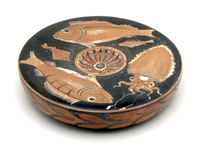 |
A Fine Red-Figure Fish Plate. Campania, c. 350-320 BC. Footed plate, with shallow sloping top, central depression, and broad turned down sides with inward curved rim. Top painted with two mullets(?) and a squid, plus a small perch and a ray. The creatures on black background, and painted with red and brownish washes, with added details in white and black. Along sides, a border of laurel leaves. The central depression (a reservoir for sauces or liquids) with rosette-like pattern. The foot painted with circular bands of black or red. A section of the foot restored, otherwise dish complete and intact, and well preserved without repairs or paint restoration. Diameter: 10". A very fine example of this less common class of ceramic.
Estimated Value $3,000 - 4,000.
View details and enlarged photo
| Realized
$3,680 |
Lot 433 |
|
Well Crafted Core-formed Amphoriskos. Levant or Italy, 3rd to 2nd century BC. Cf. Toledo, Ancient Glass, no. 158, but of stouter form. Height: 4-1/4". Nicely porportioned, this deep blue glass vessel features a flat everted lip, long cylindrical neck, and inverted rounded conical body set upon a high small foot. Opaque yellow horizontal stripes edge the lip and wind about neck and body. The piece is marverd at the shoulder, along with slight heat tooling to create subtle ribbing along the shoulder's edge. Bottle is intact and perfect with weathered, lightly iridescent surfaces. A very fine example, and noteworthy for being complete.
Estimated Value $1,000 - 1,500.
View details
| Unsold |
Lot 434 |
 |
Early Roman Cast Glass Bowl. Roman, perhaps Italy, late 1st century BC to early 1st century AD. Diameter: 5-7/8". This simple bowl nearly hemispherical in shape, with pushed up base. Cast in a clear/pale green glass, the bowl exhibits "fire polish" on the exterior, and lapidary polishing on the inside. In addition three concentric circles have been deeply engraved within. Bowl intact and free of the usual age cracks. Interior iridescence ranges from silvery to wonderfully intense lime and emerald greens to splendid corals and deep oranges. Cf. Toledo, Ancient Glass, nos. 243-246.
Estimated Value $400 - 650.
View details and enlarged photo
| Realized
$414 |
Lot 435 |
|
Superb Sidonian Amphoriskos in Violet. Roman Phoenica, 1st century AD. Cf. Sammlung Oppenlander, nos. 413, 414; no. 412, an oinochoe, perhaps from the same mold. Mold blown from a two-piece form, the bottle with thin, shallow funnel mouth, broad neck, and ovoid body on small cylindrical foot. At neck, twin drawn handles in aubergine or brown-blue. Molded design on body comprised of central band of curling floral arabesques, flanked by paired line border, with fluting above and below. Intact and perfect, this delicate artifact in superb condition. Height: 2-3/4". A choice example of this ardently collected class of early blown bottles. Bid well or you'll miss this opportunity!
Estimated Value $1,500 - 2,000.
View details
| Realized
$863 |
Lot 436 |
|
Neatly Crafted "Sauce" Plate. Roman, 1st to 2nd century AD. Cf. Sotheby's Constable-Maxwell Collection, lot no. 64. Width: 8-3/4". Blown in a colorful yellow-green glass, this footed plate has a rolled rim that has been folded to form an angled wall around the plate. The plate's interior has a cup-like center. Intact and perfect. With transparent and subtle, to more vivid iridescence in greens, violets, reds, limes, and magenta. Although light, the dish has been innovatively and ruggedly made. This dish is formed to drain sauces or juices to the central reservoir. Choice and crack free.
Estimated Value $750 - 1,000.
View details
| Realized
$437 |
Lot 437 |
|
Interesting Cylinder Bottle. Roman, 1st to 2nd Century AD. Cf. Newark, figs. 443, 444. Height: 6". Blown from a pale green glass, this bottle has a broad, flat rolled down rim, short cylinder neck, and cylinder body with fairly straight vertical sides and sharply rounded shoulders. The bottom is slightly indented. Intact and perfect, with beautiful bright metallic to transparent iridescescence of light and dark green, copper, gold, silver and deep blue-green.
Estimated Value $500 - 600.
View details
| Realized
$288 |
Lot 438 |
|
An Attractive, Large Unguentarium. Roman, c. 1st to 2nd century AD. Height: 7-1/8". Of typical form, with long tapering neck, a little constricted at its base, a small flattened ovate body, and with rounded mouth, this bottle is blown in a medium green glass. Intact and perfect, with excellent silvery iridescence within, the bottle reflecting the colors predominantly in the cool greens and violets, and the occasional cobalt. A very fine example of this type.
Estimated Value $500 - 750.
View details
| Unsold |
Lot 439 |
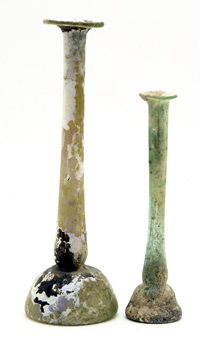 |
Lot of Two Iridescent Unguentaria. Roman, c. 1st - 2nd century AD. Heights: 5-1/4"; 7". The two delicate long-necked bottles blown from green and pale green glass. Both with similar features of flared mouth, tubular necks constricted at the bottom, and conical bodies with concave bases. The smaller's body more bell-shaped than the other. The small bottle with areas of generally thin iridescence, but occasional vivid patches. The larger has mostly opaquish silver-white iridescence with zones of vivid violet and cerulean. Both intact and perfect.
Estimated Value $200 - 300.
View details and enlarged photo
| Realized
$299 |
Lot 440 |
|
Handsome Mold Blown Flask in Amber Glass. Roman, c. 1st to 2nd century AD. Height: 5-1/2". Bottle with conical/piriform body with deeply indented base, somewhat pinched tubular neck, and lightly everted, rounded rim. Body with molded vertical ribbing. Intact and perfect, with transparent areas of iridescence, inside and out. The brown color makes for very warm golds and greens, where the silvers and violets stand out in remarkable contrast. Recommended!
Estimated Value $600 - 800.
View details
| Realized
$437 |
Lot 441 |
|
Handsome Mold Blown Flask in Amber Glass, Again! Roman, c. 1st to 2nd century AD. Height: 5-1/2". This a mate to the previous amber flask, and all remarks pertain. The only difference is that the vertical ribbing here now has a slight spiral twist. Also there are some age cracks, but the bottle appears to be sound and stable. Attractive shape, and a less common color for the period.
Estimated Value $450 - 600.
View details
| Unsold |
Lot 442 |
 |
Lot of Two Colorful Small Bottles. Roman, c. 1st - 2nd century AD. Heights: 5-1/4"; 7". The two classic Roman bottles blown from light green glass. Both with similar features of tubular necks, one slightly constricted at the bottom, and globular or ovate bodies with concave bases. The small bottle with patches of white-lilac iridescence, balanced by areas of vivid transparent violets, greens, and blues. The larger has transparent iridescence tending to the golds, green, magentas, with some indigo accents. Both intact and perfect. Very nice display objects.
Estimated Value $200 - 400.
View details and enlarged photo
| Realized
$253 |
Lot 443 |
|
Two Beautiful Minature Jars, in Yellow Glass. Roman, 1st to 3rd century AD. Cf. G.A.E. Vol. 1, pl. 67, for first; Smith, figs. 313, 314, 315, for second, also Opplander no. 578, with original bronze handle intact. Heights: 2-1/4'; 2-5/8". 1. The earliest of this pair is a "cosmetic cup" delicately blown with a wide funnel mouth set atop an inverted conical body that has rounded shoulders and a pinched waist. With a flat base. Intact and perfect, with a lovely opaquish silver-gold color that tends to greens and reds. 2. The second piece is a minature sprinkler flask with a shallow funnel mouth and cylinder neck that taperes to a constricting groove at the body junction. The squat tear or drop-shaped body sits atop a slightly raised foot. The bottle is robust and perfect with a green-brown internal patina and slight hints of iridescence. A delightful pair!
Estimated Value $350 - 550.
View details
| Realized
$276 |
Lot 444 |
|
Globular Bottle with Pinched Ornament. Roman Syria, c. 2nd to 3rd century AD. Height: 4-3/8". Another bottle utilizing pinched decoration. Blown in light green glass, the bottle with globular body having indented base, a short almost cylindrical neck, and thick, flat everted rim. Bottle intact and perfect, having a whitish internal patina, which displays an occasional hint of iridescence. Cf. Sammlung Oppenlander, no. 714. A handsome decorative type.
Estimated Value $700 - 900.
View details
| Realized
$776 |
Lot 445 |
|
Sprinkler Flask with Pinched Ornament. Roman Eastern Mediterranean, c. 2nd to 3rd century AD. Height: 4-1/2". Blown in green glass, the bottle with conical body, funnel mouth, and internal diaphragm at the throat. Along the lower body are two rows of pinched spikey protuberances, giving the bottle a sort of vegetal appearance. Intact and perfect, with internal grayish patina, and occasional hints of iridescence. Cf. Sammlung Oppenlander, no. 690, a bottle; but note a footed version, no. 713, also a sprinkler. A less common sprinkler type.
Estimated Value $650 - 800.
View details
| Unsold |
Lot 446 |
|
Large, Important Wheel-cut Flask. Roman, c. 2nd to 3rd century A.D. Cf. Sammlung Opplander no. 508. This a grand-sized version in aqua-green glass of the basic bottle/ungentarium shape: cylinder neck atop piriform body, the mouth folded and throated, with rim slightly everted. At regular intervals on neck and body, three broad cut grooves encircle the vessel, these flanked by two narrower sharper grooves. Fabulously preserved for a glass object this size, and without any of the usual age cracks seen on large heavy glass. Some minor, cleanble black crust, overall with fine transparent iridescence favoring greens and magentas, and muted coppers. Height: 12-1.8". A museum piece, not to be missed!
Estimated Value $2,500 - 3,500.
View details
| Unsold |
Lot 447 |
|
Beaker with Wheel-Cut Decoration. Roman, c. 2nd to 3rd century AD. Height: 3-3/4". Robust,of thick green glass, the cup of tapering cylindrical form, with thick weighted base. The rim knife cut when blown, and slightly inward curving. At four regular intervals, encircling bands were cut on the exterior using a lapidary wheel. Intact and perfect, with variegated opaque silvery and colorful transparent iridescence, interspersed among a gay patina. Pleasant, and a rugged display object.
Estimated Value $450 - 550.
View details
| Realized
$690 |
Lot 448 |
|
Triple Handled Cup or Lamp. Roman, 2nd to 3rd century AD. Cf. Newark, fig. 197. Height: 2-3/8". This funnel-shaped vessel is crafted in glass of light green color with three dark blue, opaque glass handles equally spaced around the sides. The tapered vessel has a wide mouth with a rolled rim and a folded ring foot. Faint green, blue, silver and purple iridescence appear on the cup and mottled purple, silver, green and black iridescence accent the handles. The cup is intact and choice; the handles are either reattached or are restorations.
Estimated Value $200 - 300.
View details
| Realized
$288 |
Lot 449 |
|
Finely Iridescent "Amhoriskos." Roman, c. 2nd to 3rd century AD. Height: 4-1/2". The vessel of tapering conical form, with sharply angled shoulders, short neck, flat everted mouth with rolled rim, and slightly indented base. Blown from light green glass, bottle intact and perfect. Part of one side with crusty patina (from water deposits?), and the other with silvery iridescence supporting a colorful range of bright golds, greens, cobalts, and magentas. A fine piece - the shape classic, and the iridescence eye catching!
Estimated Value $450 - 650.
View details
| Unsold |
Lot 450 |
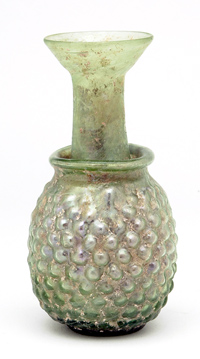 |
A Choice, Subtly Iridescent "Grape" Flask. Roman, likely Syria, c. 2nd - 3rd century AD. Height: 5". Very robust, this bottle is thickly blown from a light green glass. The funnel is mouth rather broad and deep, and the tapered neck is folded down to create a decorative ring around the shoulders. Details to the body are sharp, from the numerous globules comprising the "grapes," to the two small triangular leaves, not to mention the seam of the two-piece mold. Intact and perfect, with transparent to nearly opaque silvery iridescence, having hints of blues and violets. Rare and important. Cf. Sammlung Oppenlander, no. 470, an earlier version.
Estimated Value $1,250 - 1,750.
View details and enlarged photo
| Realized
$2,645 |
Lot 451 |
|
An Extraordinary Bottle. Roman, c. 2nd to 3rd century AD. Height: 10-1/4". This bottle is an unusual variant to the typical unguentarium. While the globular body and long tapering neck are normal. The size, coupled with the rounded funnel mouth with trailed threading, set this apart from the norm. Blown in aqua glass, the bottle is intact and perfect! Its remarkable preservation is further enhanced with zones of vivid multi-colored iridescence. A highly fortunate survival from antiquity, it is worthy of any advanced glass collection.
Estimated Value $1,250 - 1,500.
View details
| Realized
$1,725 |
Lot 452 |
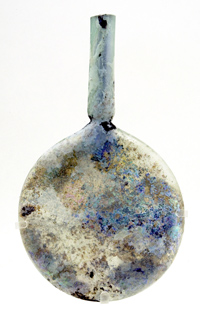 |
Large "Pilgrim's Flask" with Impressive Iridescence. Roman, c. 2nd - 3rd century AD. Height: 8". Blown in a pale green glass, the typical globular-bodied unguentarium is modified so that its body is flattened to resemble a moderately thick disk. The neck remains tubular, slightly constricted at the base, and the rim is missing. This distinctive glass form is enhanced with a lovely silver-creme iridescence with bold splashes of wonderful blue, green and cobalt coloring. Some age cracks on both sides of body, but flask appears stable and sound. Comes with custom display stand. Cf. Newark, no. 456. A choice cabinet piece.
Estimated Value $650 - 850.
View details and enlarged photo
| Realized
$1,208 |
Lot 453 |
|
Handled Ewer in Green Glass. Roman, c. 2nd to 3rd century AD. Height: 6-3/8". Blown from light green glass, the graceful vessel with elongated piriform or drop-shaped body atop integral folded foot, along with funnel mouth with rolled rim. An added single handle of trailed glass, and decorative ring at the neck are of similar but slightly darker green glass. Pitcher intact and perfect. Over areas of the body, a translucent, somewhat matte iridescence/patina, tending to the mauves, lavenders and soft greens. A stylish piece, that would enhance any collector's holdings.
Estimated Value $800 - 1,000.
View details
| Realized
$1,208 |
Lot 454 |
|
An Impressive Large Pitcher in Green Glass. Roman, 2nd-3rd century AD. The pitcher free blown, with the body of broad, swelling drop shape, which rests on high foot created by folding the base inward. The vessel's neck fairly narrow while the mouth, wide and funnel-like, has been folded to form a narrow channel. Attached at the back, a wide combed handle in the same color glass -- this with folded thumbrest. There are decorative trailed rings at the neck and below the rim. Modest repair to a small part of the vessel's shoulder, otherwise this large piece is superb, with magnificent iridescence -- ranging from silvery to green, with subtle blues, magentas, and violets. Height: 8-3/4". The vessel robust, lovely, and remarkably preserved for its size -- thus rare!
Estimated Value $4,000 - 6,500.
Cf. Hermitage Coll., no. 272.
View details
| Realized
$2,530 |
Lot 455 |
|
Square-bodied Jug in Green. Roman, c. 2nd century AD. Cf. Wolkenburg Collection, Christies' London, 7/9/91, lot 71a. Height: 4-3/4". Blown jug in light green glass, this jug features a short cylinder neck and thick flattened rim. The rectangular body is likely mold-blown to an even, square profile -- although the corners are rounded and the straight walls are a bit concave. A ridged, trailed handle is attched at one side. One lower corner has been restored to match the bottle's crusty, earthen patina. Walls, neck and handle show areas of sometimes vivid green, violet, red, lime, and indigo iridescence. Square-sided bottles remain a less common form in ancient glass.
Estimated Value $450 - 650.
View details
| Unsold |
Lot 456 |
|
Large Rectangular Jug. Rome, 2nd to 3rd Century AD. Cf. Newark, fig. 128. Height: 8-1/8". Robustly made in heavy green glass, this piece features a flattened disc-like mouth with a rolled lip, and a broad cylinder neck atop rectangular body of square section. With slightly rounded shoulders and a concave base. A wide flat handle rises vertically from the shoulder to the neck. Chipping to an air bubble in the handle. Otherwise the bottle is finely preserved. With beautiful transparent to opaque purple and green iridescence.
Estimated Value $500 - 650.
View details
| Realized
$357 |
Lot 457 |
|
Unsual Bag-like Beaker or Jar. Roman, c. 2nd to 4th century AD. Cf. G.A.E. Vol. 1, pl. 69a; Newark, figs. 109, 373, 374. Height: 3-5/8". Delicately formed from a clear or pale green glass, this bottle is crafted with a short funnel mouth that has an outwardly rolled rim, and a wide piriform body which has been deeply indented on the sides to form a square. The piece sits atop a folded thick ring foot. Neatly trailed glass threads appear at the neck. The bottle is intact and perfect. Very clean but for the inner surface on one side. With fine blue, green, silver and purple iridescence. Choice, unusual shape.
Estimated Value $400 - 650.
View details
| Realized
$230 |
Lot 458 |
 |
Lot of Three Flasks. Roman, c. 2nd - 5th century AD. Heights: 2-1/4" - 6". Earliest a medium-size bottle, with inward rolled rim, and piriform body with indented base. Also a second miniature version of the first, but body wider and more flattened. Lastly, another medium-size flask of later date, with rimless funnel mouth/neck on sharply ovate body, also with indented base. All blown from green glass. All with pleasant thin to opaque silvery iridescence, with varying nuances of greens, violets and magentas, mostly subdued. The first bottle with minor age crack on base, which is stable and seemingly solid; the second repaired at body; the third a more robust bottle and seemingly free of any problems. A good value priced lot.
Estimated Value $400 - 600.
View details and enlarged photo
| Realized
$460 |
Lot 459 |
 |
A Fine, Iridescent Little Pitcher. Roman, 3rd - 4th century AD. Height: 3-1/8". Blown in green glass, the large funnel mouth has been folded to form a triangular spout, with single trailed handle at the back. The walls of the small ovate body have been pinched six times making it almost hexagonal. A seam folded into the glass on its base almost has the appearance of a crack, but glass is sound and stable. Otherwise, only defect of note is an air bubble that has flaked away near the handle, leaving a small hole. Bottle covered with translucent silver-white iridescence with touches of subtle coloring. Attractive, and a less common type.
Estimated Value $350 - 450.
View details and enlarged photo
| Realized
$230 |
Lot 460 |
|
Finely Iridescent Flagon. Roman, c. 3rd to 4th century AD. Cf. Hayes, ROM, no. 425. Height: 3-5/8". Blown in pale green glass, this bottle has a funnel mouth with a flared and folded rim, a narrow neck, and sloping shoulders upon its cylindrical body. A heavy trailed ring of glass has been applied under the rim. A narrow ridged and folded handle appears at one side. Intact and very fine. The age-etched surfaces with delightful iridescence in mellow and warm hues of red, gold, and rose, with accents of violet and green.
Estimated Value $400 - 500.
View details
| Unsold |
Lot 461 |
|
Light Green Bottle of Graceful Profile. Roman, c. 3rd AD. Height: 7-3/8". Body of elegant narrow piriform shape, with partly collared mouth, slightly constricted neck, all atop integral folded foot. On either side a decorative strip of pinched glass culminating in two circular handles. Aside from a modest, stable age crack, and repairs to handles, vessel finely preserved. Note an earlier version, 1st century, in Sammlung Oppenlander, no. 539. A rare type!
Estimated Value $750 - 950.
View details
| Unsold |
Lot 462 |
|
Sprinkler Flask with Violet Iridescence. Roman, perhaps Syrian, c. 3rd to 4th century AD. Cf. Hans Cohn Collection, fig. 67; Sammlung Oppenlander no. 495. Height: 3-3/4". Blown in light yellow glass, this bottle has a shallow funnel mouth with an inward folded rim, short cylinder neck, spherical body, and an indented base. The body is tooled with decorative slanting and parallel lines which encircle it. With blue, green, gold, and a particularly fine violet iridescence. A few modest age cracks on one side which appear to be stabilized. Otherwise, finely preserved. Said to be found in Palestine.
Estimated Value $300 - 400.
View details
| Realized
$207 |
Lot 463 |
|
A Solid and Unusual Sprinkler Flask. Roman Judaea, c. 3rd to 4th century AD. Height: 3-3/8". Robustly made of thick green glass, the flask shaped as a twin-handled jar with globular body and indented base, a short cylindrical neck with wide flattened mouth, and two trailed and folded handles at the sides. Within the neck the unusual restricting diaphragm of this class of bottle. Intact and perfect with patchy to "etched" iridescence over much of its surfaces. The crusty iridescence tends to the silvery, with sometimes intense cobalt, while the etched surfaces create a subtle map of blues, greens, magentas, and an occasional hint of gold. An excellent artifact, bespeaking alike man made antiquity and the transforming qualities of time and nature. Handled sprinklers appear to be rare.
Estimated Value $600 - 800.
View details
| Realized
$437 |
|
|